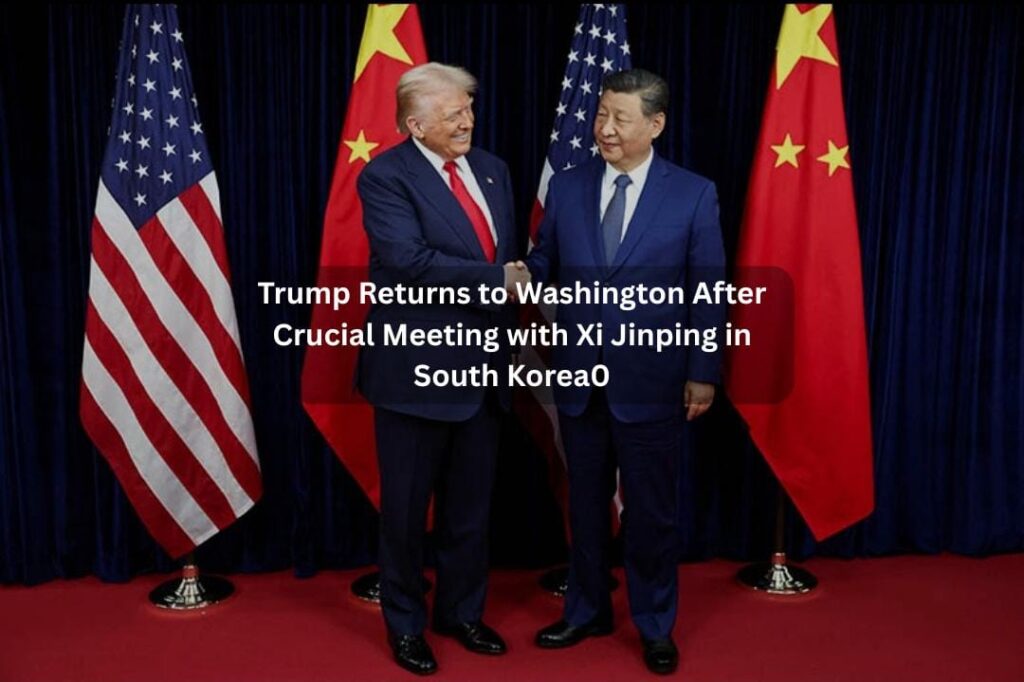Trump Returns to Washington After Landmark Talks with Xi Jinping: Hints of a Trade Thaw on the Horizon

By News & Roots Bharat | October 30, 2025
After a whirlwind diplomatic journey across Asia, former U.S. President Donald Trump is flying back to Washington aboard Air Force One, concluding a tour that could mark a new chapter in U.S.–China relations. The highlight of his trip — a much-anticipated meeting with Chinese President Xi Jinping in Busan, South Korea — is already stirring global conversations about a possible easing of trade tensions between the world’s two largest economies.
The presidential aircraft lifted off from Busan around 1:15 p.m. local time (12:15 a.m. ET), signaling the end of Trump’s three-nation tour through Malaysia, Thailand, and South Korea. He is expected to land at the White House later this afternoon, around 3:05 p.m. ET, where aides say he will brief advisors and cabinet members on the outcomes of the high-stakes visit.
A High-Stakes Meeting That Drew Global Attention
The Trump–Xi summit — held in the historic city of Gyeongju, South Korea — lasted nearly one hour and forty minutes, according to officials present. Described as “productive and cordial,” the meeting reflected a rare sense of optimism after months of diplomatic chill. Members of the U.S. delegation were visibly pleased as they emerged, with Commerce Secretary Howard Lutnick giving reporters a thumbs-up — a gesture interpreted as a sign of cautious success.
Alongside Trump were several senior U.S. officials: Secretary of State Marco Rubio, Treasury Secretary Scott Bessent, and U.S. Trade Representative Jamieson Greer. All appeared upbeat as they departed for the flight home, suggesting that the discussions had achieved more than symbolic value.
China Resumes U.S. Soybean Imports — A Key Breakthrough
One of the most tangible outcomes of the Busan talks came from the trade front. In a move that surprised many observers, China resumed its purchases of American soybeans after months of suspension. The halt, originally triggered by trade friction and tariff disputes, had severely affected U.S. farmers, especially across the Midwest.
U.S. Agriculture Secretary Brooke Rollins announced the breakthrough on X (formerly Twitter), confirming that multiple cargoes of soybeans had been sold to Chinese buyers. “This is a positive step forward for our farmers,” she wrote, calling it a sign that dialogue is once again delivering results.
According to a report by Reuters, the initial shipment amounts to about 180,000 metric tons for delivery in December and January — not massive in volume but deeply symbolic. The resumption of trade represents an olive branch from Beijing, showing goodwill just ahead of the Trump–Xi meeting.
Last year, China purchased nearly 27 million metric tons of soybeans from the United States — more than any other nation. But after relations soured earlier this year, China had shifted its imports to Brazil and Argentina, leaving American producers frustrated and uncertain. The new purchases, therefore, carry significance that extends far beyond agriculture — they represent a soft reset in economic diplomacy.
A Cordial Tone Amid Complex Issues
The Busan encounter was notably warmer in tone than past Trump–Xi meetings. As cameras rolled, Trump opened by referring to Xi as “a friend of mine — for a long time now,” emphasizing mutual respect. “We’ve already agreed on a lot,” he added, “and we’ll agree on more right now.”
Xi Jinping, for his part, praised the stability of U.S.–China relations under both leaders. He highlighted their continued communication through calls and letters, saying that such dialogue had created “the necessary foundation for today’s meeting.” The Chinese president also pointed to areas of shared concern — from regional peace to economic stability — noting that “both countries have a responsibility to ensure prosperity and balance in the world.”
“The world faces many challenges,” Xi said. “China and the United States can shoulder our duties as major powers and achieve great things together — for our peoples and for global stability.”
Their exchange, though light on new agreements, reflected an effort to re-establish trust and maintain open channels after years of volatility.
Inside the Discussions: Trade Takes Center Stage
While both leaders avoided delving into contentious topics such as Taiwan or the South China Sea, trade dominated the agenda. Analysts believe the U.S. administration’s immediate goal is not sweeping reform, but de-escalation — halting the cycle of tariffs and countermeasures that have hurt industries on both sides.
Emily Kilcrease, an economic security expert at the Center for a New American Security (CNAS), explained that Washington’s current approach is pragmatic.
“There’s no expectation that this meeting will solve structural issues like overproduction or IP theft,” she noted. “It’s about lowering tensions and showing that dialogue can replace confrontation.”
In other words, the Busan summit might not rewrite trade rules overnight, but it could prevent the relationship from sliding into deeper hostility.
Trump’s Asia Tour: Optics and Objectives
Trump’s Asia swing — including stops in Kuala Lumpur, Bangkok, and Busan — was crafted as a display of diplomatic engagement and economic leadership. Each stop underscored the message that the United States remains a central player in shaping the Indo-Pacific order.
In Busan, the closing scene was symbolic: American and Chinese flags side by side, both leaders shaking hands before entering private discussions. For Trump, who has long portrayed himself as a dealmaker on the global stage, the imagery served as both a diplomatic statement and a political message to voters back home — America’s interests come first, but cooperation is back on the table.
The Broader Significance
Observers see the renewed warmth as a sign of shifting global dynamics. With tensions easing, the U.S. and China may be inching toward a “managed competition” model — one that balances rivalry with pragmatic cooperation.
Economists point out that even limited trade gestures, such as soybean purchases, can create ripples in markets and political narratives. “Confidence matters as much as contracts,” one trade analyst said. “If both sides keep talking, investment and stability will follow.”
For now, the atmosphere in both capitals appears cautiously hopeful. Neither Trump nor Xi offered grand declarations, but the diplomatic body language — smiles, handshakes, and positive statements — told its own story.
Looking Ahead: A Fragile but Promising Reset
As Air Force One races across the Pacific toward Washington, the broader question looms: can this newfound warmth hold?
Experts suggest that the coming months will test whether symbolic gestures can translate into lasting policy change. Agricultural trade, technology access, and supply chain resilience remain unresolved challenges.
Still, the Busan meeting has succeeded in one critical way — it has restarted dialogue at the highest level. For two nations whose economies shape the global future, that alone is no small achievement.
For now, both Washington and Beijing seem willing to trade confrontation for cooperation. The flight home may mark the end of Trump’s Asia tour, but it also signals the beginning of what could become a new phase in U.S.–China relations.



